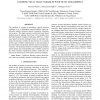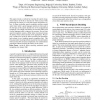334 search results - page 3 / 67 » Improving speech playback using time-compression and speech ... |
ICASSP
2011
IEEE
14 years 3 months ago
2011
IEEE
The problem of acoustic-to-articulatory speech inversion continues to be a challenging research problem which significantly impacts automatic speech recognition robustness and ac...
SPEECH
1998
14 years 11 months ago
1998
We present the theory for heteroscedastic discriminant analysis (HDA), a model-based generalization of linear discriminant analysis (LDA) derived in the maximum-likelihood framewo...
INTERSPEECH
2010
14 years 6 months ago
2010
This paper presents a method for rescoring the speech recognition lattices on-the-fly to increase the word accuracy while preserving low latency of a real-time speech recognition ...
ICASSP
2009
IEEE
15 years 6 months ago
2009
IEEE
In recognizing spontaneous speech, the performance of typical speech recognizers tends to be degraded by filled and silent pauses, which are hesitation phenomena frequently occur...
TSD
2005
Springer
15 years 5 months ago
2005
Springer
Although speech, derived from reading texts, and similar types of speech, e.g. that from reading newspapers or that from news broadcast, can be recognized with high accuracy, recog...


